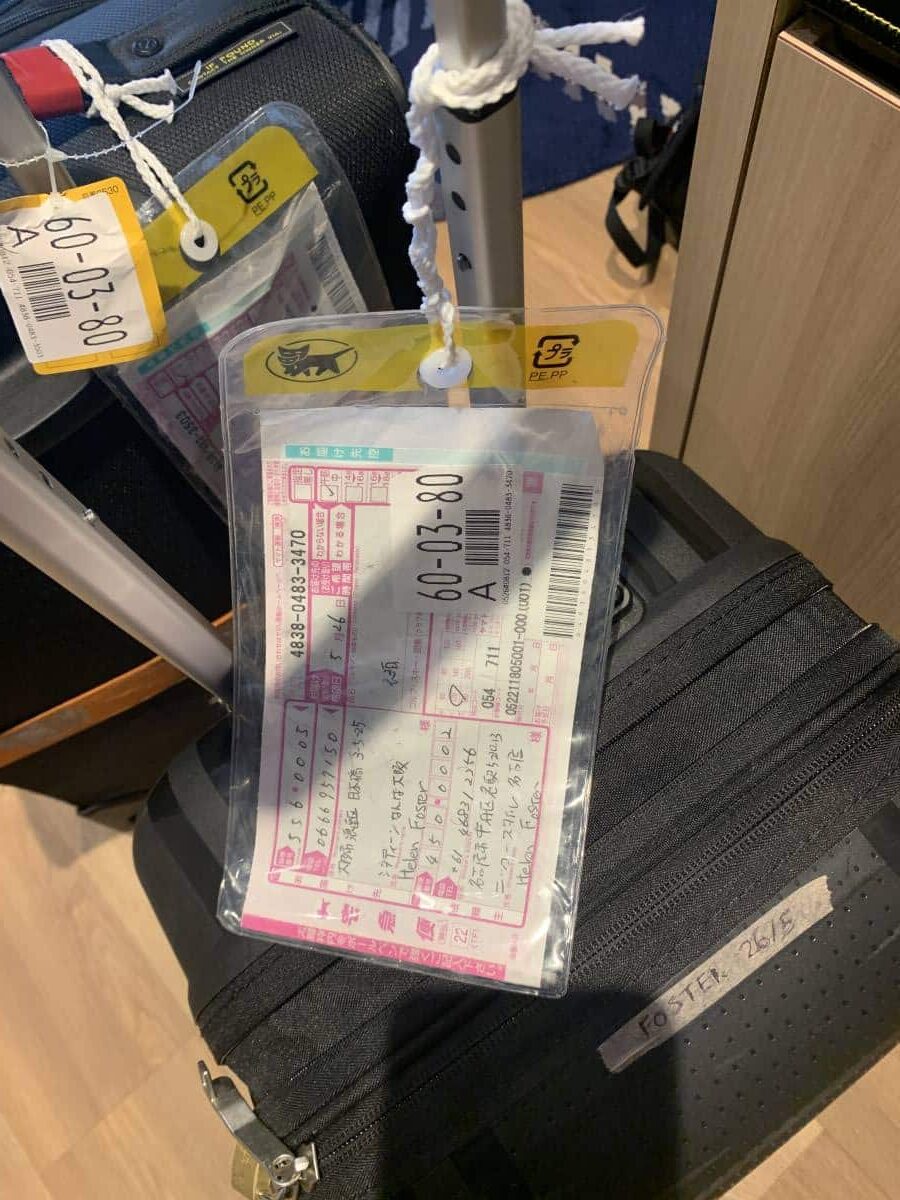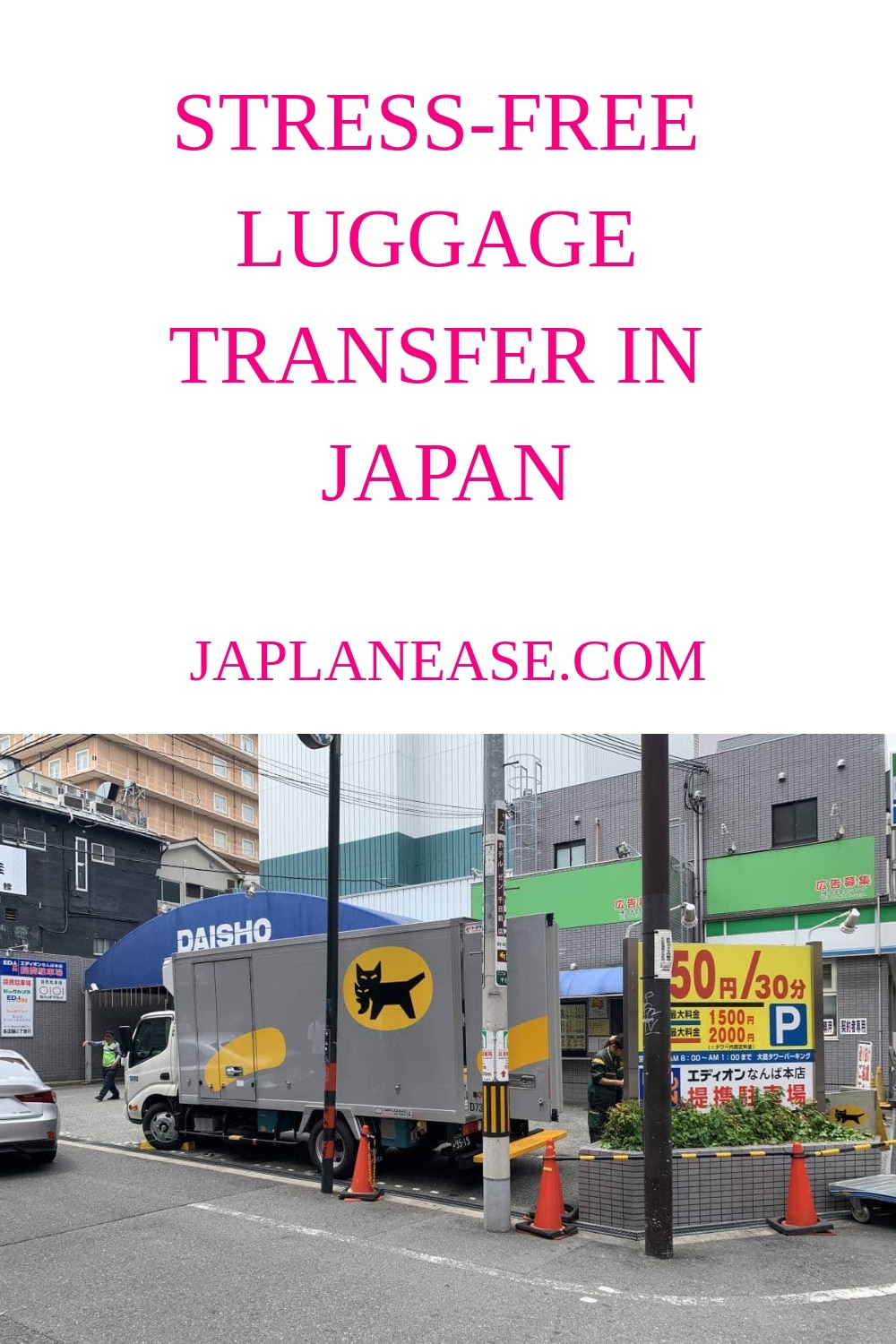- How to Visit Osaka’s Amazing Lion Head Shrine - 7 July 2025
- How Long Should You Spend in Hakone? - 22 June 2025
- When Are Japan’s Public Holidays? - 19 June 2025
There are a lot of differences between local travelers and foreign tourists on Japanese trains – but one of the big ones is that we’re all lugging massive cases while the local travelers don’t have any. One reason for this is that locals usually send big cases in advance via a luggage transport service. I tried this three times on my last trip, and it made every journey more pleasant. So, here’s my guide for using luggage transfer in Japan.

Article by Helen Foster. Disclosure: Some links in this post are affiliate links. See our Affiliate Disclosure.
Quick Summary
Luggage transfer delivers your luggage between two destinations in Japan.
The biggest company offering the service is called Yamato.
It’s easiest to organize between hotels, but you can also ship from convenience stores in most areas.
Costs vary by bag size. I paid 1850 yen for a small bag and 2190 for a large one between Nagoya and Osaka.
The service is very organized and very efficient, but we’ll give a few tips that add an extra level of security in the piece that follows.
How Do You Organize Luggage Transfer?
The main company that deals with luggage transfer in Japan is called Yamato, and they have offices all over the country. Once you learn to recognize the logo of a black cat on a yellow circle (see above), you’ll see their vans everywhere.
There are two ways to organize a Yamato luggage pick-up – the easiest is to ask at your hotel reception. Ask them for luggage transfer or, if they don’t speak much English, try saying Yamato or Ta-Q-Bin (takkyubin) and they’ll usually understand and bring out a pink form.
The benefit of having your hotel organize luggage transfer is that they fill out the forms in Japanese for you, and they will usually also call the receiving hotel to check that they offer the service and to let them know to expect your luggage. Once the form is filled in, it will be attached to your bag (like the one below), and off it goes.

If you are staying at a hotel that doesn’t offer the service, in an Airbnb, or somewhere else where there isn’t a 24-hour reception to receive the bags, you can go to the local Yamato office (find a list of Yamato locations here), a convenience store – or, sometimes even another hotel – and have them organize it for you.
You will need the form filled out in Japanese so make sure you have your hotel details printed out in Japanese (you’ll find this on their website or, if you book via booking.com, they give you a Japanese confirmation that you can print, so the clerk has the address handy.
How Long Does it Take to Get Your Bags?
Once you leave your bag, the Yamato team then picks it up and, via their huge network of drivers and delivers it to your next hotel. Depending on the distance between the two destinations, it might arrive the next day or take 48 hours to get to you.
To give you an idea of how long things took on my last trip – we shipped two bags from Nagoya to Osaka when we checked out of our hotel at 10am Thursday morning. When we arrived at the hotel at 3pm Friday afternoon (we spent Thursday night at another stop with just our essentials), they were brought out by the check in staff as we checked in.
The next journey my bag took was from Osaka to Sendai – this is quite a long distance, so I sent the bag before the early morning cut-off time on a Thursday, and it was at my hotel when I got back from sightseeing at 2pm on Friday – but it arrived in Sendai the night before (you’ll find out how I know this in a minute).
Then, because we shifted some dates around, we also shipped the luggage from Sendai to our main hotel in Tokyo, meaning that we could just do a one-night stopover in another Tokyo hotel with hand luggage. We sent them on check-out on Sunday, and they were at our hotel when we checked in the next afternoon.

Need Extra Planning Help?
Our Japan trip planners can help. You might like our First-Timers Japan Planner, which will help you plan your trip to Tokyo, Kyoto and Osaka step-by-step, including tips on everything from picking hotels to sightseeing and dining. Or our super-duper Tokyo Disney Planner makes arranging your park trip MUCH easier. Find them in our Planners store – printable and digital versions are available.
How Much Does it Cost?
The amount you pay depends on the bag size and the distance your luggage travels, but here’s what I paid for each leg of my last trip.
Nagoya to Osaka: 1850 for my cabin-sized bag and 2190 for Mr Japlanease’s bigger bag (that’s them below).
Osaka to Sendai: 2010 for my cabin-sized bag.
Sendai to Tokyo: 1750 for my cabin-sized bag, 2090 for a larger bag.

Is There Anything You Can’t Ship
Yes, although most are not things you’ll carry on your holidays, like oil or paint. Things that might be under restrictions, though, include nail varnish, perfume, phones, laptops, and tablets – these can’t go on luggage transport planes, so if you’re shipping over a long distance, you either leave these out or check before you book that it’s not going by plane.
My Tips When Sending Luggage
Think Ahead: When planning your itinerary, consider when you might want to ship luggage – if you have a one-night stop between two longer stops, that’s the perfect time to travel bag-free.
Bring an Overnight Bag: Chances are you will need a few things with you while your luggage makes its way to you, and you’ll need something to put those in. I usually use my airline hand luggage bag, but I was trying to travel even lighter than normal on my last trip and only carried a tiny bag on the plane, so I threw in a tote bag and used that as my overnight bag.
Check With Your Hotel(s): Most hotels will send or accept luggage, but it’s a good idea to check with them in advance (many include it as a FAQ on their website) or when you check in to make sure.
Know the Pick-Up Time: Ask your hotel what time bags need to be with them to go that day – one reason my bag got to Sendai so quickly was that I checked with the hotel when the first Yamato pick-up of the day was, and they told me to make sure reception had it by 8.30 am; With a check out of 11am, I might have missed that if I hadn’t asked in advance.
Add some extra security: How did I know how fast my bag got to Sendai? I put an AirTag in it to see exactly where they were at any given time. This gave me a greater sense of security that they were going the right way – and a rough idea of when they might turn up.

Yamato is excellent at what they do, but accidents happen, and if they do lose a bag, you will be far more likely to get it back quickly if you can tell them where it is. This happened to someone in my Facebook group recently when the paper label fell off her bag in transit. Because she had tracked her luggage, she could tell Yamato exactly where in their system it was.
For those who aren’t too technical, you follow your tracker via your phone, so make sure you pick the right type for your technology. AirTags work with Apple phones (buy Airtags and have them delivered here).
If you’d prefer to use another product, a type of tracker called Tile works with both Apple and Android phones. You can buy Tile Trackers here.
Photograph Your Luggage: I hadn’t thought of doing this, but people added this as an extra tip after the above story came out in my group. It means you also can show Yamato what type of case they are looking for, which will speed up its return. I also stuck my name on the outside on some tape I had with me.
Shipping To/From The Airport
You can also send your luggage directly from the airport to your hotel, freeing up your first day of travel, or send it back to the airport just before your flight – handy if you’ve gone overboard with the shopping!
If you’re dropping off at the airport, ask about the exact delivery time, as it varies by hotel location and drop-off time. It can be delivered on the same-day, but you shouldn’t probably assume it will be the next day, so pack your hand luggage accordingly.
There is also a service you can book on Klook which can deliver same day – although it’s a little more pricey than the other options. See more details on luggage delivery here.
If you’re shipping back to the airport, make sure you allow enough time as the company likes to leave a buffer – Osaka to Haneda, for example, is at least two days – so you might be without your luggage a little bit longer than shipping from hotel to hotel.
You can get a timing estimate on the Yamato website – you will need to translate it from Japanese, though, or speak to your hotel, who can double-check things for you.
Save Money with Klook & Japlanease
If you plan on buying tickets or tours from Klook for when you’re in Japan, you could save up to 10 per cent by using the code JAPLANEASEKLOOK at the checkout. Click here to see what’s on offer.
T&Cs apply. Some items, including Tokyo Disney and USJ tickets, are not available for discounts.
What to Pack in Your Overnight Bag
If you use luggage shipping, you will probably be without your luggage for one night, so you need to be prepared for that and pack a bag of essentials.
I can’t know your exact needs, but the essentials I pack include… medication, glasses/contact lenses, valuables, charges for my phone and power packs, etc, my passport, and undies.
You might also want to add a change of clothes if the weather is bad or you hate wearing the same things two days running.

Things you might not need to pack include toiletries; Japanese hotels provide pretty much everything you need in your room or at the front desk and nightwear – check with your hotel, but many Japanese hotels supply a night shirt for you to use (that’s one above), so, you don’t need to bring anything.
The Benefits of Luggage Transfer
In case you’re still unsure, here are the benefits of luggage transfer that I found on my last trip.
It speeds everything up. Not carrying luggage up and down steps (or, in my case, looking for a lift) made moving around the stations much easier.
On my next trip, I have a fairly short transfer time between Shinkansen on one journey. I might be concerned about making that transfer with luggage, but if I ship it ahead, I don’t have to worry about that.
Trains are much easier: I only take a cabin-sized bag with me, but even with that, getting onto trains and finding somewhere to put the bag is a faff. If you have heavier bags, you either have to lift them onto the overhead racks or book the seats with the luggage space behind them (if this is news to you, then read our post on the Shinkansen luggage rules so you’re up-to-date).
It frees up time: Generally, you arrive at your next destination in Japan before the check-in time for your hotel so you can start sightseeing immediately – but, if you have bags, you can’t do that; you have to drop them off at your hotel – or, stash the bags in a locker and pick it back up later. Both of these eat into sightseeing time. Without bags, you can hit the ground running in your new destination.
I hope that helped you understand how to use the luggage shipping service in Japan, but if you do have any questions, or more tips, please join the Japlanease Facebook Group and drop them in there.

Who Writes This Blog?
My name is Helen Foster, and I’m a journalist and author. My travel articles have appeared in publications including The Australian, Escape, RAC Horizons, Jetstar Magazine, Sainsbury’s Magazine, and more.
I’ve traveled to Japan eight times before – solo and with my partner and visited over 25 towns and cities. My last visit was November 2024 so, everything here is pretty up to date.

